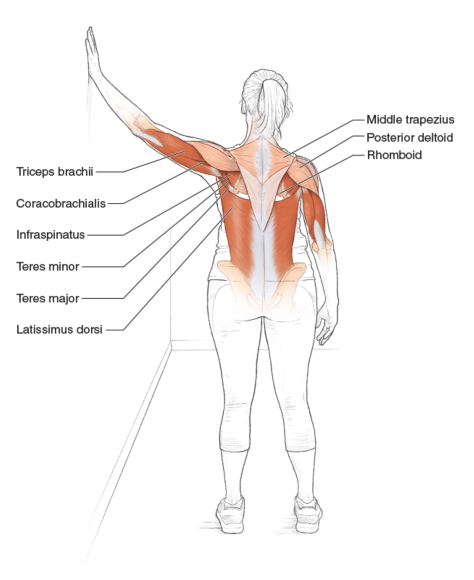Shoulder adductor stretch
This is an excerpt from Stretching Anatomy-3rd Edition by Arnold G Nelson,Jouko Kokkonen.
Execution
- Stand upright with the feet shoulder-width apart and the left side of the body facing a wall about an arm's length away.
- Place the palm of the left hand on the wall at shoulder height.
- Gradually “walk” the fingers up the wall as high as you can without pain.
- Flatten the hand against the wall, and lean the weight on the hand.
- Hold this position for the desired length of time.
- Repeat these steps for the opposite side.
Muscles Stretched
Most-stretched muscles: Left coracobrachialis, left infraspinatus, left latissimus dorsi, left teres major, left teres minor, left triceps brachii
Less-stretched muscles: Left posterior deltoid, left middle trapezius, left rhomboids
Stretch Notes
This stretch makes it easier to perform throwing actions as well as overhead around-the-house activities such as painting and window cleaning. Also, this stretch can help relieve the pain associated with shoulder impingement, shoulder bursitis, rotator cuff tendinitis, and frozen shoulder. This activity especially helps a frozen shoulder. Keeping the weight resting on the fingers as they “walk” up the wall will help strengthen the shoulder abductors as well as stretch the shoulder adductors when you rest the weight at the terminal height.
Keeping the arm in a straight line between the body and the wall places the stretch equally on the anterior and posterior muscles. Moving the hand toward the front of the body places more stretch on the posterior muscles and moving the hand toward the back stretches the anterior muscles more. You can combine this stretch with the intermediate lower-trunk lateral flexor stretch in chapter 5.
More Excerpts From Stretching Anatomy-3rd EditionSHOP

Get the latest insights with regular newsletters, plus periodic product information and special insider offers.
JOIN NOW



